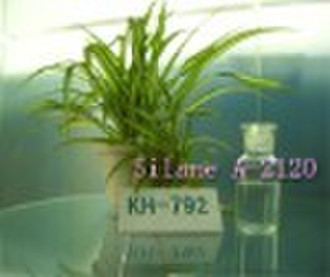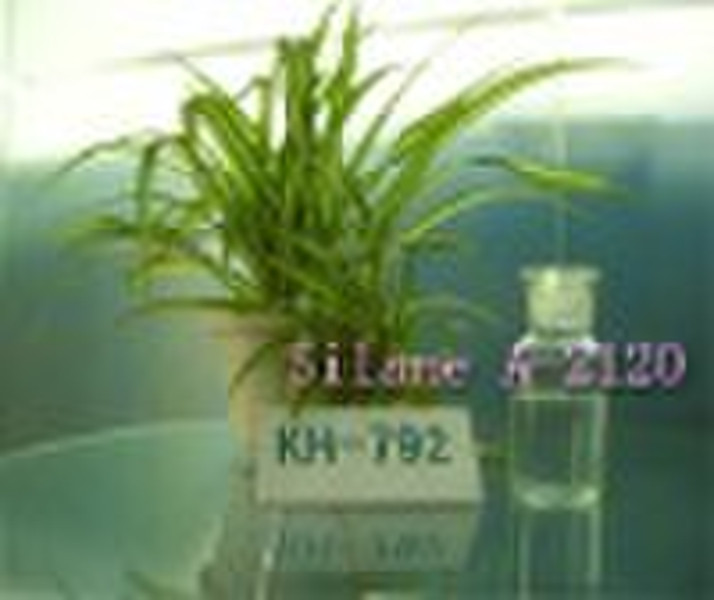silane A-1120
南京乡, 中国

Lancy Huang
联系人姓名
基本信息
| 化学文摘社编号. | 1760-24-3 |
|---|---|
| 纯洁的 | 97% |
| 出生地 | China (Mainland) |
| 牌子的名字 | FEPA |
| 模式的数量 | KH-792 |
SilaneKH-792(A-1120) Introduction Chemical Name : N (beta-aminoethyl) gamma-aminopropyltrimethoxy-silane CAS NO. : 1760-24-3 Molecular Formula:NH2(CH2)2 NH(CH2)3Si(OCH3)3 Foreign Company's Trademark: A-1120(America Union Carbon) Z-6020(Dowcorning) KBM-603(ShinEtsu) GF9(Wacker) silane KH-792 finds use as an : · Adhesion promoter in polysulfide, polyvinyl chloride plastisol, silicone tow-part urethanes and epoxy adhesives and sealants · Additive in phenolic and epoxy molding compounds · Additive to latex coatings, adhesives and sealants · Adhesion promoter in one-part silylated urethane adhesives and sealants based on organofuntional silane SPURSM Technology. Features and Benefits FeatureBenefit Polyamino functionality · Provides reactive site for amino-reactive resins. · Good wetting of substrates. Trifunctional silane · Excellent adhesion to inorganic substrates such as metal, glass, etc. · Superior adhesion to plastics when employed in SPUR Technology-based adhesives or sealants. Typical Physical Propertie Physical Form Clear liquid Color, Pt-Co max 25 Specific Gravity at 20oC 1.010 1.030 Refractive Index at 20oC 1.4425 1.4460 Purity, % 97.0 min Applications silane KH-792 may be used as an additive, eliminating the need for special primers in numerous bonding applications. Specific systems that demonstrate improved adhesion when silane KH-792 is used are: RTV Silicones and Hybrid Silane-Crosslinked Sealants Silane KH-792 addition to one- and two-part silicone-crosslinked sealants improves adhesion to a variety of substrates, including glass, steel, aluminum and concrete. This silane can dramatically enhance adhesion to a wide array of plastics when used in combination with SPURSM Technology for silylating urethane polymers. (For formulation and silylated prepolymer preparation information, please refer to Literature bulletin #112-026-30, Silquest Organofunctional Silanes Crosslinkers and Adhesion promoters for Urethane Adhesives and Sealants. Polysufide Sealants When added to one- and two-part polysulfide sealants, silane KH-792 provides better adhesion to a variety of substrates, including glass, aluminum and steel. Silane KH-792 is typically used at a loading of 0.5 to 1.0 percent by weight to the sealant. It disperses well and produces cohesive failure in the sealant rather than adhesive failure of the bond between the sealant and the substrate. Furthermore, the use of silane KH-792 can eliminate the need forprimers normally required to achieve adhesion to surfaces. Plastisol Sealants Adding silane KH-792(0.5 to 1.5 weight percent) as a replacement for polyaminoamide adhesion promoters in plastisol sealants improves bonding to metal substrates. In addition to increased strength, the silane-modified plastisol sealant has better overall appearance than a system that uses polyaminoamide adhesion promoters. Silane KH-792-modified plastisol systems have a very light color, and the cured compound is bubble-free. Additive in Phenolic and Epoxy Molding Compounds Silane KH-792, as an additive in phenolic and epoxy molding compounds, reduces the water absorption of molded composites. This, in turn, leads to improved wet electrical properties, particularly at low frequencies. High-temperature strength properties are also improved. Product Safety When considering the use of any Nanjing LIPAI products in a particular application, you should review our latest Material Safety Data Sheet and ensure that the use you intend can be accomplished safely. For Material Safety Data Sheets and other product safety information, contact the Nanjing LIPAI. Before handling any other products mentioned in the text, you should obtain available product safety information and take necessary steps to ensure safety of use .
-
支付方式
我们接受:









